Hanoi Travel Guide
Vietnam's small and vibrant capital lies at the heart of the northern Red River Delta, and is a city of lakes, leafy boulevards and open parks with a French colonial feel. Hanoi was founded in 1010, and became the centre of government for the Indochina Union under French rule in 1888. In 1954 it became the official capital of independent Vietnam.
Today ancient crumbling buildings dating from the 11th century lie scattered among grand French colonial residences, while shrines and monuments to Vietnam's first president, Ho Chi Minh, sit in the shadow of modern high-rise buildings. The streets of the Old Quarter preserve age-old customs, where trade takes visitors back half a century, and temples, pagodas and monuments reflect the historic character of Vietnam.
Although a city of historical importance, as well as the social and cultural centre of Vietnam, it is a surprisingly modest and charming place, far slower and less developed than Ho Chi Minh City in the south. Hanoi has retained its appealing sense of the old world, despite the onset of a brisk tourism trade in 1993, absorbing the boom of hotels, travellers' hangouts, and the gradual infiltration of western-style food and fashions into the once inaccessible city.
As the early morning mist rises from the serene Hoan Kiem Lake, tracksuit-clad elders perform the slow movements of tai chi, like park statues coming to life. Streets fill with activity, mopeds and bicycles weave among pedestrians, while cyclo drivers (three-wheeled bicycle taxis) clamour for attention, and postcard vendors cluster around tourists like bees sensing an open honey pot.
Hanoi is fast becoming one of the most enticing and interesting cities in Asia. As a cultural centre there are traditional water puppet shows, music and dance performances. It is also a good base for excursions to the beautiful Halong Bay, or into the Hoang Lien Mountains inhabited by several hill tribes.
Things to do in Hanoi
The bustling nature of this city seamlessly synchronises with its old-world feel. This combination is the reason it is so attractive to backpackers and luxury holidaymakers alike. As if this wasn't enough, its rich history has been steeped in a mythic aura due to its relatively recent introduction to the tourist landscape.
Hanoi is as much a romantically charming city as Ho Chi Minh City is a hive of commercial interest and big-city living. Its lively merchant quarters and bar districts host tourists until first light, where cheap accommodation and drinks make the fun that much more enjoyable. During the day, museums, temples, memorials and the famous Old Quarter of Hanoi provide a myriad of cultural experiences unique to the city.
Within Hanoi's busy streets lie some of Vietnam's most tranquil cloisters and sanctuaries, tucked away from the daily flurry.
If the city lights become too bright, Sapa and Bac Ha are two nearby country getaways that offer an opportunity to experience rural Vietnam. In addition, no trip to Hanoi would be complete without a foray into Halong Bay, often accompanied by a stay at Cat Ba Island. These emerald waters are famous for their adventure activities, set in a bay littered with thousands of small islands and inlets, which are the product of a giant dragon who stormed through the bay aeons ago, according to legend.
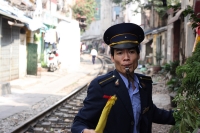
Old Quarter
The ancient meandering streets of the Old Quarter are each named after the crafts and speciality trades traditionally practised by the original artisan's guilds in the 13th century. Each guild was grouped around a temple, or dinh, dedicated to the particular beliefs of the village from where the guild originated, and many of these temples are open to the public today. The early merchant's quarter affords an intriguing glimpse into life centuries ago with covered markets, and the ancient narrow buildings that still line the streets, known as tube or tunnel houses that contained shops. Businesses were taxed according to the width of their storefront and resulted in shops only seven foot (2m) wide with a series of storerooms, workshops and living quarters extending behind to a length of up to 197ft (60m). Many streets are still devoted to a predominant trade such as silks, religious objects or textiles, silver jewellery, antiques, and there are numerous art galleries and craft stores, as well as cafes and pavement restaurants lining the streets. Traffic within the Old Quarter is a chaotic mix of bicycles, motorbikes and pedestrians passing noisily down the narrow streets and shady alleyways.
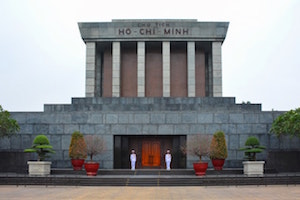
Ho Chi Minh’s Mausoleum
Ba Dinh Square was where Ho Chi Minh read out the Declaration of Independence in 1945, and is the site of annual national celebrations today. The Ho Chi Minh Mausoleum dominates the site's west side and is where the embalmed body of the beloved public figure, 'father of the modern state', and 'liberator of the Vietnamese people' is displayed. The body of Ho Chi Minh is enclosed in a glass case, the traditional way to honour famous communist leaders. Security is tight, there is a strict dress code and it is imperative to maintain a respectful demeanour while inside; this also means no photographs. Nearby is the Ho Chi Minh Museum that commemorates his life, housing a collection of military orders, correspondence, manifestos and photographs that illustrates the crucial role he had in the country's history.
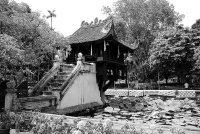
One Pillar Pagoda
One Pillar Pagoda was constructed to celebrate the tale of the heirless Emperor Ly Thai Tong, who dreamt about receiving a son from the Buddhist goddess of mercy and compassion, seated on a lotus flower. He married shortly after and had a son, and the pagoda was built to honour the event. It is the most interesting of the city's numerous pagodas and, beneath the ornate curved roof, people come to pray for fertility and well-being, with allegedly miraculous effects. The unique wooden structure was designed to resemble a lotus flower, the Buddhist representation of enlightenment, emerging out of the water, with the single stone pillar its symbolic stalk. It was destroyed by the French during the first Indochina War and was subsequently rebuilt.
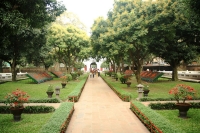
Temple of Literature (Van Mieu)
The Temple of Literature is Vietnam's historical seat of learning and is the most sacred place for the disciples of Confucius. It is one of the few remaining buildings from the original city founded by Emperor Ly Thanh Tong in the 11th century and is a well-preserved example of Vietnamese architecture. It became the site of the country's first university in 1076. Consisting of a complex of small buildings and five walled courtyards, it was an exclusive establishment teaching the principles of Confucius. In the third courtyard is a pond, the Well of Heavenly Clarity, and beside it are 82 stone stelae, mounted on tortoises and engraved with the names of successful graduates. Over a period of 900 years, thousands of Vietnamese scholars graduated from the university. In honour of their teacher's legacy, there is also a temple dedicated to Confucius, a place where the king and his mandarins would make sacrifices.
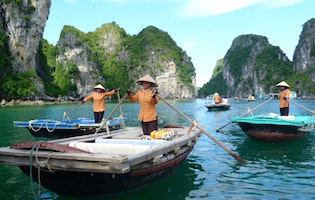
Halong Bay
The natural wonder of Halong Bay has been declared a UNESCO World Heritage Site. Renowned for its spectacular scenery and limestone grottos and caves, the bay is peppered with over 1,600 inlets and tiny islands emerging almost mystically out of the emerald waters of the Gulf of Tonkin. Wind and wave erosion have scored the site to form dramatic rock shapes, many of which contain caves. Many of the islands have been named for their astonishing resemblance to their namesakes, such as Dragon, Incense Burner, Pair of Roosters and Man's Head Islands. The weird protuberances have been at the source of several local legends, particularly about a dragon whose thrashing tail created the bay and its islands. The name Vinh Ha Long means 'where the dragon descended into the sea'. The most impressive cave is the Hang Dau Go (Grotto of the Wooden Stakes), an extensive grotto with rock formations presenting various eerie images in the mysterious light. It was named from the Battle of 1288 when General Tran Hung Dao prepared hundreds of stakes to be planted in the riverbed of the largest chamber to counter a boat attack. Nearby the beautiful Hang Thien Cung cave is famous for its sparkling stalagmites and stalactites. When booking a cruise in advance, travellers should consider reserving a night or two, to experience Halong Bay at its most picturesque; sunrise, sunset and star-scattered night.
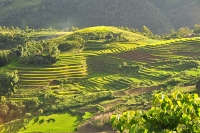
Sapa and Bac Ha
The old hill station of Sapa sits high on the edge of a plateau surrounded by spectacular scenery and the Hoang Lien Mountains, which boast Vietnam's highest peak, Fan Si Pan. Sapa functions as a market town and a gathering spot for local tribes who come into town to trade every weekend. The market is excellent for buying handicrafts and people watching. Colourful tunics of the Dao and Giay people mix with the black and blue clothing and silver ornamentation of the Black Hmong tribe, while bright red scarves cover the heads of the Red Hmong who carry large woven baskets on their backs brimming with goods. Nearly 75 miles (140 km) from Sapa is the small town of Bac Ha. Situated in a valley, Bac Ha is famous for its Sunday market. Much less touristy than Sapa, the market is a riot of colour and noise, a place not only for trade but also for socialising. All paths leading into town are filled with people going to market, some riding horses or water buffalo, and the square is a mix of different minorities, buying and selling, or gathered in groups around a central pot of food. The Flower Hmong are the most vivid, with richly coloured clothes of bright red, blue and pink, and skirts embroidered with delicate flowers. The markets have become a major tourist attraction and it is important that visitors to the region are sensitive to local culture and traditions, particularly when taking photographs of people.
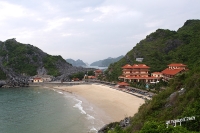
Cat Ba island
For most, a trip in Halong Bay means at least a night on Cat Ba Island. Many enlist for a package tour of one night on the island and one on a boat, but Cat Ba is worth investing extra time in. This 54 sq mile (140 sq km) island offers impressive beach relaxation, and hardcore outdoor activities include kayaking, trekking and world-class rock climbing. Travellers who wish to relax can choose between three beaches that are within walking distance of town. Each is spacious and all are protected inlets with views of Halong islands. Beaches one and three are the most secluded and offer beautiful views from the short walks along surrounding cliff lines. Those looking for something more rugged can visit the many limestone cliffs dotting the island, as they're ideal for rock climbing; hotels located on the town's main strip offer guides and gear. Various treks range in length but most are fairly steep. However, the reward is well worth it, as they give a bird's-eye-view of the island's national park, which is also home to the rare Cat Ba Langur. All hotels can arrange excellent boat tours of the surrounding islands. These include visits to deep caves with stalagmites and stalactites, secluded swimming holes, floating fish farms and kayaking. The tour is the same regardless of who it's booked through, so the cheaper the better. Whether it has been a relaxing day of sun and sea or one of thrilling adventure, it must end at the bay's floating restaurant, which has some of the best seafood in Vietnam.
Eating Out
Hanoi, like most of Vietnam, is a bountiful spot for culinary exploration. Vietnamese cuisine is defined by its fresh ingredients, use of herbs and fast cooking times. It is unlike any other Asian cuisine, and sampling its many variations is one of the true pleasures of visiting Hanoi. The ubiquitous pho noodle soup served with slices of beef (bo) or chicken (ga), fresh bean sprouts, and various spices is available everywhere around the city.
Although there are many fine-dining eateries, a more democratic and authentic way to dine is to eat at the many street-side restaurants, sitting on tiny plastic stools. Here travellers can sample inexpensive classic dishes such as banh cuon, steamed rice pancakes filled with finely chopped pork; nem ran, fried spring rolls, and bun cha, flame-cooked pork often served in a noodle soup. A well-known street-food establishment is Cha Ca La Vong on Cha Ca Street. Here patrons can find the iconic North Vietnamese dish cha ca, which is fried fish and dill patties with noodles.
A lot of these restaurants only serve one dish, which they've perfected. So travellers should put aside their expectations of good service, pleasing decor and a varied menu, and try a different spot every day. Afterwards, they can visit a cafe for some ca fe (coffee) and a pastry, or a bia hoi (draft beer) tavern for some low alcohol lager.
Shopping
Hanoi offers a less frenetic and commercialised shopping experience than Ho Chi Minh City in the south of the country. Traditional arts and crafts are more popular here than mass produced goods, and night markets are lively social occasions not to be missed.
The old town is where most of the art galleries are situated. A lot of up and coming artists exhibit here and if travellers can spot quality and bargain skilfully, they can pick a truly unique and worthwhile memento of their Hanoi visit. Popular souvenirs also include paraphernalia from the communist and war eras, including Chairman Mao branded goods, medals, bullets, and Zippo lighters, the latter invariably of modern provenance and not found in a former battle zone as claimed by the salesman.
Other souvenirs include silk garments, wooden carvings, shoes from silk or bamboo, ethnic weaving, rice paper notebooks and paintings, and the distinctive conical hats that have been worn for centuries and are still much in evidence today. Visitors should look out for hats made in Hue, which each have a unique poem inside the rim. Shoppers should avoid buying gemstones unless they have the skill to tell the difference between jewels and polished glass.
Nightlife
Hanoi is a city with an abundance of choices for night-time entertainment. After dark the Old Quarter takes on a new life, and is where visitors can find crowded sidewalk spots to sip on cheap draughts of beer while perched on a stool. Bia Hoi Junction has a mixed patronage of locals and tourists who congregate around drinks for prices as low as 5,000 VND. The Old Quarter is also a prime location to devour street food by night, providing a wealth of tasty, quickly prepared options. For more experienced culinary navigation through the countless options, travellers can sign up for a night-time street food tour.
Hanoi has no shortage of nightclubs, trendy bars and live music venues scattered around the West Lake area and Hoan Kiem district. For a more cultural experience, travellers can head to legendary Binh Minh's Jazz Club, located in the French Quarter or visit the historic Hanoi Opera House, which still hosts live performances every so often. Visitors can also tap into Hanoi's growing contemporary art scene with a visit to Manzi Cafe and Art Space. Local art exhibitions and film festivals are also quite common around the city.
Getting Around
Public transport is limited to buses, which are extremely cheap, but slow, crowded, and a challenge for non-Vietnamese speakers. There are plenty of taxis to be hired and this is the safest and easiest way to get across the city, though travellers should make sure the meter is switched on and change is given.
Motorbike taxis are also a cheap and easy way to get around, but the driving can be nerve-wracking. Renting a car or a motorbike are also popular options; all cars come with a driver/guide, which is a good idea considering the chaotic nature of the streets.
Visitors should be cautious about renting a self-drive motorbike, bearing in mind the primary cause of injury and death among foreigners in Vietnam is motorcycle accidents. Two-seater cyclos (cycle rickshaws) are plentiful and can be flagged down anywhere, but should be avoided at night. Fares should be negotiated beforehand and a map is useful, as many drivers don't speak English.
Hanoi Climate and Weather
Hanoi has a humid tropical climate that is characterised by monsoons, like most of northern Vietnam. Summers (between May and September) are very hot with plenty of rain and average temperatures between 76F (24C) and 91F (33C); while winters (from November to March) are cool and relatively dry, averaging between 57F (14C) and 72F (22C). Anything is possible during the transitional months of April and October, and spring often brings light rain. The hottest month of the year is June. January is the coolest month, usually beset with a cold north-easterly wind.
Vietnam travel info
Electricity
Electrical current in Vietnam is 220 volts, 50Hz. Plugs are either the two flat-pin or the two round-pin type. Three-blade plugs can be found in some of the newer hotels.
Language
The official language in Vietnam is Vietnamese, but Chinese, English and French are also spoken. Some tour guides may speak Russian and Japanese; numerous ethnic languages are also prevalent in particular areas.
Money
The official currency is the Vietnamese dong (VND), and currency can be exchanged at banks, bureaux de change and larger hotels. Visa and MasterCard are becoming more widely acceptable, particularly in Hanoi, Ho Chi Minh City and all major tourist centres; travellers who plan to take money out of Vietnam can leave with amounts of less than 15 million dong or USD 5000 (or equivalent in other foreign currencies) without having to declare to customs.
Tipping
Most restaurants and hotels in Vietnam now add a five to ten percent service charge to their bills, though porters in top hotels will expect a small tip. Hired drivers and guides are usually tipped, and it is customary to round up the bill for taxi drivers in the cities.
Health
Health risks in Vietnam include Hepatitis A and B, typhoid, Japanese encephalitis, bilharzia and diarrhoea. Malaria prophylaxis is recommended for travel outside the main cities and towns, the Red River delta and north of Nha Trang; reported cases of dengue fever have increased in recent years, so visitors should take care to protect themselves from mosquito bites, particularly in the southern Mekong Delta region.
Travellers should seek medical advice about vaccinations at least three weeks before leaving for Vietnam, and everyone 12 years of age and older should get fully vaccinated for COVID-19 before visiting. Most visitors prefer to drink bottled water, even though the local tap water is drinkable.
Decent health care is available in Hanoi and Ho Chi Minh City (Saigon), where there are English-speaking doctors, but more complicated treatment may require medical evacuation. Pharmacies throughout the country are adequate, but travellers should check expiry dates of medicines carefully and be aware that some medicines are counterfeit. Health insurance is essential.
Safety
Vietnam is a relatively safe travel destination and violent crime is uncommon. However, petty crime occurs in Ho Chi Minh City (Saigon) and other large cities and tourist hot spots, so visitors should be wary with their belongings when in crowds and on public transport. Travellers are advised to leave valuables in their hotel safe and avoid obvious displays of wealth. During the monsoon season (usually between June and October) the country is prone to serious flooding and typhoons (until December), particularly in the Mekong Delta and Central Region.
Local customs
Travellers should try to dress modestly when away from the beaches (shoulders covered and shorts below the knee) and avoid excessive public displays of affection. Shoes must be removed on entering religious sites and a donation is expected when visiting a temple or pagoda. Photography is restricted at ports, harbours and airports, and it is polite to ask permission before taking photographs of people, especially of ethnic minorities. Visitors should never leave chopsticks sticking upright in a bowl of rice, as it has strong connotations of death. Travellers should use a hand as opposed to pointing with a finger.
Doing business
Pride and tact are important to bear in mind, as practices tend to be more formalised than in Western countries. Often it is best to be introduced rather than approach the person with whom business is intended to avoid creating suspicion. Negotiations and settlements may take longer as the Vietnamese like to examine contracts thoroughly. Formal clothing is common but the dress tends to be more casual in summer months. It is important to be on time for business appointments, as the Vietnamese consider lateness rude.
Business people are always addressed as Mr., Mrs., and Ms., followed by their personal name (not family name), unless otherwise referred; it is worth finding out in advance. Shaking hands with both hands is the most respectful greeting, though bowing is still popular among the older population, and meetings always begin with the exchange of business cards, which should be given and received with both hands; each person expects to receive one, so it's best to bring a vast supply. Business hours are typically 8am to 5pm Monday to Friday with an hour taken at lunch, and 8am to 11.30am on Saturdays.
Duty free
Travellers to Vietnam over 18 years do not have to pay duty on the following items: 200 cigarettes, 20 cigars, 250g tobacco; 1.5 litres alcohol with alcohol content higher than 22 percent and 2 litres below 22 percent; up to 5kg tea and 3kg coffee; perfume and items for personal consumption within reasonable amounts; other goods to the value of 10 million Vietnamese dong.
Communications
The international country code for Vietnam is +84. The outgoing code is 00, followed by the relevant country code (e.g. 001 for the United States or Canada). WiFi availability is widespread, expecially in the cities; travellers can purchase local SIM cards for unlocked phones.
Passport & Visa
All visitors must have sufficient funds for the duration of their stay, onward or return tickets, and all documents needed for next destination. It is highly recommended that travellers' passports have at least six months' validity remaining after the intended date of departure from their travel destination. Immigration officials often apply different rules to those stated by travel agents and official sources.
Entry requirements
Visas are required. US passport holders must have a passport valid for a minimum of 30 days beyond the expiry of the visa. Visas are not required for stays of up to 30 days for US nationals arriving at Phu Quoc (PQC).
Visas are required. Passports must be valid for a minimum of 30 days beyond the expirty of the visa. Visas are not required for stays of up to 30 days for UK nationals arriving at Phu Quoc (PQC).
Visas are required. Passports must be valid for a minimum of 30 days beyond the expirty of the visa. Visas are not required for stays of up to 30 days for Canadian nationals arriving at Phu Quoc (PQC).
Visas are required. Passports must be valid for a minimum of 30 days beyond the expiry of the visa. Visas are not required for stays of up to 30 days for Australia nationals arriving at Phu Quoc (PQC).
Visas are required. South African passports must be valid for a minimum of 30 days beyond the expirty of the visa. Visas are not required for stays of up to 30 days for South African nationals arriving at Phu Quoc (PQC).
Visas are required. Irish passports must be valid for a minimum of 30 days beyond the expirty of the visa. Visas are not required for stays of up to 30 days for Irish nationals arriving at Phu Quoc (PQC).
Visas are required. New Zealand passports must be valid for a minimum of 30 days beyond the expirty of the visa. Visas are not required for stays of up to 30 days for UK nationals arriving at Phu Quoc (PQC).
Useful contacts
113 (Police); 115 (Ambulance); 114 (Fire)Embassies / consulates in other countries
Embassy of Vietnam, Washington DC, United States: +1 202 861 0737.
Embassy of Vietnam, London, United Kingdom (also responsible for Ireland): +44 20 7937 1912.
Embassy of Vietnam, Ottawa, Canada: +1 613 236 0772.
Embassy of Vietnam, Canberra, Australia: +61 2 6286 6059.
Embassy of Vietnam, Pretoria, South Africa: +27 12 362 8119.
Embassy of Vietnam, Wellington, New Zealand: +64 4 473 5912.
Embassies / consulates in Vietnam
United States Embassy, Hanoi: +84 24 3850 5000.
British Embassy, Hanoi: +84 24 3936 0500.
Canadian Embassy, Hanoi: +84 24 3734 5000.
Australian Embassy, Hanoi: +84 24 377 40100.
South African Embassy, Hanoi: +84 24 3936 2000.
Irish Embassy, Hanoi: +84 24 3974 3291.
New Zealand Embassy, Hanoi: +84 24 3824 1481.



